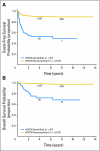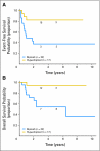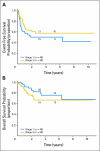Significance of MYCN amplification in international neuroblastoma staging system stage 1 and 2 neuroblastoma: a report from the International Neuroblastoma Risk Group database
- PMID: 19047282
- PMCID: PMC2651034
- DOI: 10.1200/JCO.2008.17.9184
Significance of MYCN amplification in international neuroblastoma staging system stage 1 and 2 neuroblastoma: a report from the International Neuroblastoma Risk Group database
Abstract
Purpose: Treatment of patients with localized neuroblastoma with unfavorable biologic features is controversial. To evaluate the outcome of children with low-stage MYCN-amplified neuroblastoma and develop a rational treatment strategy, data from the International Neuroblastoma Risk Group (INRG) database were analyzed.
Patients and methods: The database is comprised of 8,800 patients. Of these, 2,660 patients (30%) had low-stage (International Neuroblastoma Staging System stages 1 and 2) neuroblastoma, known MYCN status, and available follow-up data. Eighty-seven of these patients (3%) had MYCN amplified tumors.
Results: Patients with MYCN-amplified, low-stage tumors had less favorable event-free survival (EFS) and overall survival (OS) than did patients with nonamplified tumors (53% +/- 8% and 72% +/- 7% v 90% +/- 1% and 98% +/- 1%, respectively). EFS and OS were statistically significantly higher for patients whose tumors were hyperdiploid rather than diploid (EFS, 82% +/- 20% v 37% +/- 21%; P = .0069; OS, 94% +/- 11% v 54% +/- 15%; P = .0056, respectively). No other variable had prognostic significance. Initial treatment consisted of surgery alone for 29 (33%) of 87 patients. Details of additional therapy were unknown for 14 patients. Twenty-two patients (25%) underwent surgery and moderate-intensity chemotherapy; another 22 underwent surgery, intensive chemotherapy, and radiation therapy. Nine of the latter 22 underwent stem cell transplantation. Survival in patients who received transplantation did not differ from survival in those who did not receive transplantation.
Conclusion: Among patients with low-stage, MYCN-amplified neuroblastoma, outcomes of patients with hyperdiploid tumors were statistically, significantly better than those with diploid tumors. The data suggest that tumor cell ploidy could potentially be used to identify candidates for reductions in therapy. Further study of MYCN-amplified, low-stage neuroblastoma is warranted.
Figures



References
-
- Strother D, London WB, Yap J, et al: Surgery and restricted use of chemotherapy as treatment of low-risk neuroblastoma: Preliminary results of Children's Oncology Group protocol 9641. International Society of Paediatric Oncology (SIOP) XXXVIII Congress Meeting, Geneva, Switzerland, September 17–21, 2006
-
- Matthay KK, Sather HN, Seeger RC, et al: Excellent outcome of stage II neuroblastoma is independent of residual disease and radiation therapy. J Clin Oncol 7:236-244, 1989 - PubMed
-
- Kushner BH, Cheung NK, LaQuaglia MP, et al: International neuroblastoma staging system stage 1 neuroblastoma: A prospective study and literature review. J Clin Oncol 14:2174-2180, 1996 - PubMed
-
- Evans AE, Silber JH, Shpilsky A, et al: Successful management of low-stage neuroblastoma without adjuvant therapies: A comparison of two decades, 1972 through 1981 and 1982 through 1992, in a single institution. J Clin Oncol 14:2504-2510, 1996 - PubMed
-
- Berthold F, Treuner J, Brandeis WE, et al: Neuroblastoma study NBL 79 of the German Society for Pediatric Oncology: Report after 2 years [in German]. Klinische Padiatrie 194:262-269, 1982 - PubMed
Publication types
MeSH terms
Substances
LinkOut - more resources
Full Text Sources
Medical

